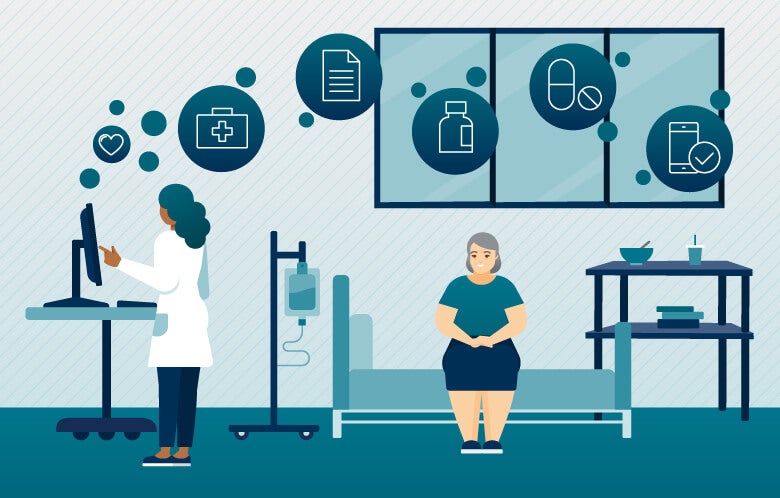The HIMSS conference and exhibition held in Chicago, Illinois, was expected to unite more than 40,000 health and information technology (IT) professionals from around the world. Opening to the John Lennon song “Imagine,” the theme of this year’s conference was “Health that connects and Tech that cares”. Keynote speakers and industry experts discussed the challenges with today’s healthcare global landscape and provided insights into how healthcare leaders should be engaged in the development of technology and how the larger medical community should help to guide deployment.
Offering a historical perspective, experts shared insights into both the healthcare industry and the emerging technology landscape. Making way for access to healthcare without reserve requires health equity that allows equal access to care with fairness, kindness, and grace, addressing social factors, biases, and acknowledging the social determinants of health that contribute to global health disparities.
The challenges of healthcare have not changed. There is an aging population, funding challenges, staff shortages and consumers wanting a different type of service and experience. In the United States, experts cite the need to integrate a fragmented health system from a collection of services that leave the consumer to navigate and figure it out, to an integrated system that provides better care coordination, mobility of care, and home as a care site where care can be proactive and not reactive. Global alliances and innovation will lead to the continued development of interoperable digital technologies that help create an infrastructure where models of care can shift, data is available for just in time utilization, predictive analytics can aid decision making, and transformation can occur to redefine the borders of care delivery.
The conference focused on a few key themes: 1) healthcare redesign needs to have health equity as a forethought and not an afterthought; 2) consumers want relationships and care to be a team sport with technology second nature to the delivery of care; 3) technology focus should not be only on development but also on deployment with active engagement of the medical community; and 4) digital AI disruption is here, posing utilization, ethical, accountability, and governance questions.
Health Equity
Industry experts refer to health equity as a state of mental and social wellbeing. Equity is a state of rights and opportunities where there is not just a perception of availability of healthcare, but an actual feeling of appropriate access and fair treatment. The US Office of the National Coordinator (ONC) outlined the role they are playing in the development of policy standards and advancing both the development and use of health IT to improve health equity and patient outcomes. Focus areas include:
- Building a digital foundation by incorporating data standards, closing health IT gaps through improved certification criteria, and creating alignment of health IT activities across all Health and Human Services (HHS) agencies.
- Facilitating and making interoperability easy through TEFCA and API’s, the USCDI Core data elements, and the provision of an SDOH Toolkit identifying key considerations and approaches to information standardization and exchange.
- Promoting information sharing, through the enforcement of information blocking rules, expanding education and outreach, embracing health equity by design principles for data capture and use, and transparency in areas such as algorithm use and safety.
Healthcare as a Team Sport with Technology
Both leaders and clinicians refer to challenges with successful handoffs to appropriate levels of care, as well as effective community integration. Consumers and/or patients are ultimately left without the connections or services they need to manage their own care. Care delivery is increasingly moving into the home environment facilitating the adoption of virtual technologies and the deployment of devices that enable a platform of care. The requirements of technology utilization for both the healthcare provider and the consumer need to be top of mind. Role, workflow, and technology services require support. Technologies should facilitate cross-continuum care but remain seamless, promote efficiency, and be sensitive not to block the delivery of care.
Digital Disruptive Technologies
Generative AI technologies such as ChatGPT and OpenAI are here. Recommendations are to actively engage to understand and develop responsible deployment. A focus should be placed on enterprise-wide governance identifying the risks and the ability of addressing risks to patient safety and the quality of care. Generative AI is not simple, and the medical community must determine the when, where, and how. Ethical and legal issues must be addressed and include:
- Machine output is not based on deliberation and individuals may interpret the output as humanistic intelligence capable of understanding.
- Bias of information is a gray area yet to be fully tested.
- Shared confidential information can be queried.
- Who is responsible when something goes wrong?
There is widespread recognition for the need for joint development, the implementation of safety protocols and policies to help distinguish real from synthetic information, and a way to govern and audit to promote truth and safety beyond a reasonable doubt.



